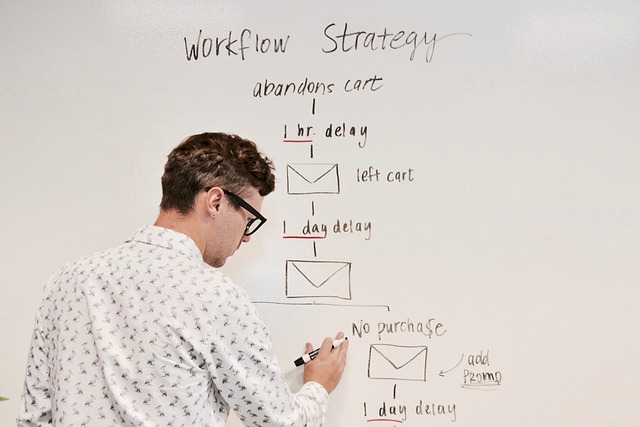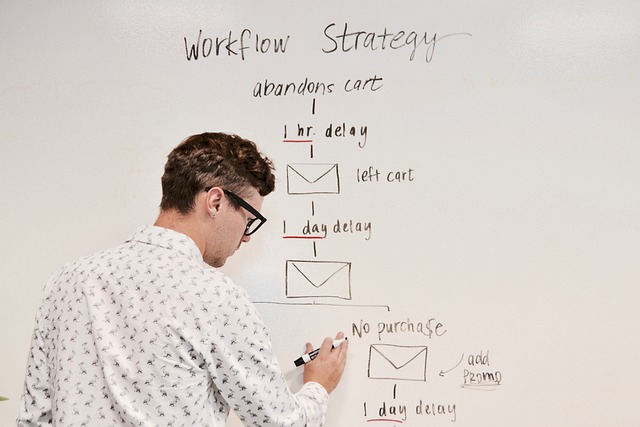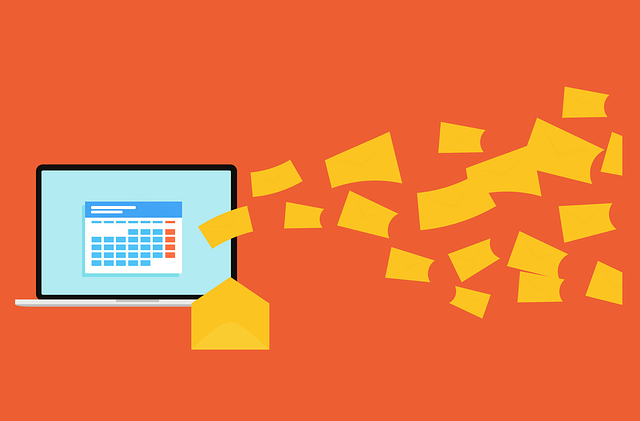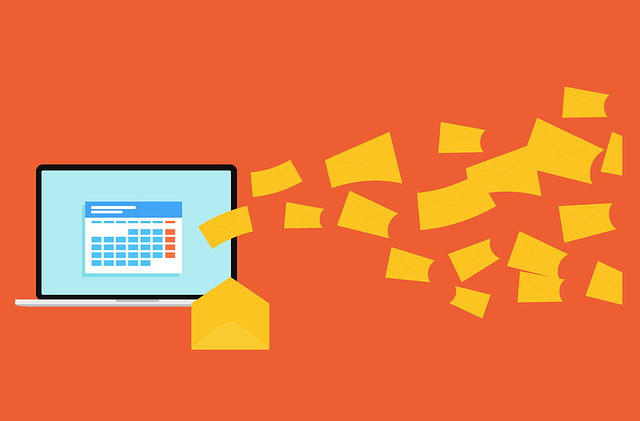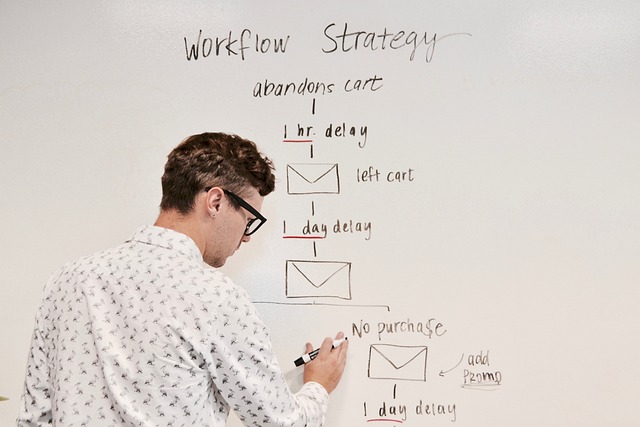Did you know that 75% of B2B businesses use email automation as part of their marketing strategy? Email automation has become a critical tool for B2B businesses, allowing them to streamline their communication processes and achieve higher levels of efficiency and effectiveness.
In this article, we will explore the strategies for success in email automation for B2B businesses.
To begin with, it is crucial to understand your target audience. By gaining insights into their needs, pain points, and preferences, you can tailor your email campaigns to resonate with them. Additionally, developing a clear and effective email strategy is essential for achieving your business goals. This involves defining your objectives, setting measurable targets, and crafting compelling messages.
Segmenting your email list is another crucial step in successful email automation. By dividing your audience into specific groups based on demographics, behavior, or interests, you can personalize your emails and deliver relevant content that resonates with each recipient.
Furthermore, creating compelling and relevant email content is key to engaging your audience. By addressing their pain points, providing solutions, and offering valuable insights, you can establish yourself as a trusted authority in your industry.
Finally, automating email sequences and workflows can save you time and effort while ensuring consistent communication with your audience. By setting up triggers and workflows, you can automatically send targeted emails based on specific actions or events.
In conclusion, email automation is a powerful tool for B2B businesses. By understanding your target audience, developing a clear strategy, segmenting your email list, creating compelling content, and automating workflows, you can achieve success and drive meaningful results for your business.
Key Takeaways
- Understanding the target audience is crucial for tailored email campaigns
- Segmenting the email list based on demographics, behavior, and interests allows for personalized content
- Automating email sequences and workflows saves time and ensures consistent communication
- Tracking and analyzing email performance helps optimize email automation strategy
Understand Your Target Audience
Discovering the desires and pain points of your target audience is crucial for creating personalized and impactful emails that will resonate with them. By identifying pain points, you can address the specific challenges your audience faces and provide solutions that meet their needs.
This requires a deep understanding of their customer journey, from initial awareness to final purchase. Customer journey mapping allows you to visualize each step and touchpoint along the way, enabling you to tailor your emails accordingly. By aligning your email content with the different stages of the customer journey, you can guide your audience towards making a purchase decision.
Once you have a clear understanding of your target audience and their pain points, you can develop a clear and effective email strategy that delivers value at every touchpoint, ultimately driving conversions and building lasting relationships.
Develop a Clear and Effective Email Strategy
Creating a well-defined and powerful email plan is essential for achieving desired outcomes in B2B communication. To effectively engage your target audience, it’s crucial to develop a clear and effective email strategy.
This involves crafting targeted messaging that resonates with your recipients and compels them to take action. Start by understanding the pain points and challenges your audience faces, and then tailor your emails to address these specific needs.
Additionally, focus on email optimization techniques such as crafting compelling subject lines, using engaging visuals, and including clear calls-to-action. By implementing these strategies, you can increase open rates, click-through rates, and conversions.
In the next section about ‘segmenting your email list for personalization,’ you’ll learn how to further enhance your email strategy and maximize its impact.
Segment Your Email List for Personalization
To truly connect with your target audience and make your emails stand out, you need to segment your email list for personalized communication that speaks directly to their unique needs and interests. Email personalization techniques and effective segmentation practices are crucial for achieving this level of customization. Here are three key strategies to help you get started:
-
Demographic Segmentation: Divide your email list based on demographic information such as age, gender, location, and job title. This allows you to tailor your content to each group’s specific preferences and priorities.
-
Behavioral Segmentation: Analyze your subscribers’ past actions and interactions with your emails to categorize them based on their behavior. This can include factors like purchase history, engagement levels, and website activity. By understanding their behavior, you can send targeted emails that are more likely to resonate with each individual.
-
Interest-based Segmentation: Group your subscribers based on their stated interests or preferences. This can be done through surveys or preference centers. By sending content that aligns with their interests, you can increase engagement and build stronger connections.
By implementing these email personalization techniques and effective segmentation practices, you can create compelling and relevant email content that resonates with your audience.
Create Compelling and Relevant Email Content
Crafting captivating and relatable email content is like painting a vibrant masterpiece that effortlessly captures your audience’s attention and leaves a lasting impression.
To achieve this, you need to employ effective writing techniques and optimize your subject lines.
Start by understanding your audience’s pain points and desires, and tailor your content accordingly.
Use storytelling to engage your readers and make your emails more relatable.
Incorporate persuasive language to convince them of the value you offer.
To optimize subject lines, keep them concise, intriguing, and personalized.
A/B test different variations to see which ones generate higher open rates.
Additionally, consider using emojis or personalization tokens to grab attention.
By implementing these writing techniques and subject line optimization strategies, you can create compelling and relevant email content that resonates with your audience.
Now, let’s explore how to automate email sequences and workflows.
Automate Email Sequences and Workflows
Start streamlining your communication process by automating email sequences and workflows, effectively saving time and enhancing productivity. With email customization, you can create personalized emails that resonate with your B2B audience.
Automation tools like Mailchimp and HubSpot allow you to set up email sequences, where a series of pre-designed emails are automatically sent to your contacts based on specific triggers or actions. This ensures that your prospects receive a consistent flow of information and helps nurture them through the sales funnel.
Additionally, automation tools enable you to create workflows that automate repetitive tasks, such as sending follow-up emails or assigning tasks to team members. By automating your email sequences and workflows, you can streamline your processes, increase efficiency, and focus on more strategic tasks.
Transitioning to the next section, tracking and analyzing email performance will help you optimize your email automation strategy for continuous improvement.
Track and Analyze Email Performance for Continuous Improvement
Maximize the impact of your email campaigns by tracking and analyzing their performance, empowering you to make data-driven decisions and continuously improve your results. Email metrics and A/B testing are essential tools for understanding how your emails are performing and identifying areas for improvement.
By tracking metrics such as open rates, click-through rates, and conversion rates, you can gain valuable insights into the effectiveness of your email campaigns. These metrics allow you to see which subject lines, content, and calls to action are resonating with your audience and which ones are falling flat. Armed with this information, you can make data-driven decisions to optimize your emails for better results.
A/B testing is another powerful tool for email performance analysis. By testing different variations of your emails, such as subject lines, content, or send times, you can determine which version performs better. This allows you to continuously refine and improve your email campaigns based on real data and audience preferences.
To help you visualize the impact of tracking and analyzing email performance, here is a table showcasing key email metrics and their importance:
| Metric | Description |
|---|---|
| Open Rate | Percentage of recipients who open your email |
| Click-Through Rate | Percentage of recipients who click on a link within your email |
| Conversion Rate | Percentage of recipients who complete a desired action, such as making a purchase |
| Bounce Rate | Percentage of undeliverable emails |
| Unsubscribe Rate | Percentage of recipients who unsubscribe from your email list |
By regularly monitoring and analyzing these metrics, you can identify trends, spot areas for improvement, and continuously optimize your email campaigns for success. So start tracking and analyzing your email performance today to take your B2B business to the next level.
Frequently Asked Questions
How can I ensure that my email content is relevant and compelling to my target audience?
To ensure your email content resonates with your target audience, start by creating captivating subject lines that grab their attention. Use vivid imagery and language to pique their curiosity and entice them to open your email.
Additionally, utilize dynamic content in your emails to personalize the message and make it relevant to each recipient. By tailoring your content to their specific needs and interests, you’ll create a compelling email that engages and motivates your audience to take action.
What are some effective strategies for segmenting my email list for personalized email campaigns?
To effectively segment your email list for personalized email marketing campaigns, start by analyzing your audience and their preferences. Divide your list based on demographics, past behavior, and interests. This allows you to tailor your content to specific segments, increasing engagement and conversion rates.
Implement dynamic content that adapts to each segment’s needs and preferences. By delivering relevant and personalized messages, you can build stronger relationships with your subscribers and achieve higher email marketing success.
How can I automate my email sequences and workflows to save time and increase efficiency?
To save time and boost efficiency in your email marketing, consider automating your email sequences and workflows. By using email automation tools, you can streamline your processes and ensure timely delivery of personalized content.
Tailoring your email content to individual recipients is made easier through email personalization techniques, allowing you to create more relevant and engaging messages.
Some top software options for automating email sequences and workflows include Mailchimp, HubSpot, and ActiveCampaign. These tools offer a range of features to help you automate and optimize your email marketing efforts.
What are some key metrics I should track and analyze to measure the success of my email campaigns?
To measure the success of your email campaigns, focus on two key metrics:
-
Open rates: Open rates indicate the effectiveness of your subject lines and overall campaign appeal. By tracking open rates, you can gauge how many recipients are actually opening your emails. This metric is crucial in understanding the initial impact of your campaigns.
-
Click-through rates: Click-through rates measure the engagement and interest of your audience. This metric tells you how many recipients are not only opening your emails but also clicking on the links within them. By tracking click-through rates, you can determine how effective your email content and calls-to-action are in driving further engagement.
By analyzing and optimizing these crucial metrics, you can make data-driven decisions to improve the performance of your email campaigns. This will help you achieve higher engagement and conversions.
Are there any best practices or tips for continuously improving email performance based on the analytics and data collected?
To continuously improve email performance, focus on two key areas: deliverability rates and subject line optimization.
Improving deliverability rates involves maintaining a clean email list, avoiding spam filters, and using authentication protocols.
Optimize subject lines by making them concise, compelling, and personalized.
Analyze data on open rates, click-through rates, and conversion rates to identify trends and make data-driven decisions.
By implementing these best practices, you can enhance the effectiveness of your email campaigns and drive better results.
Conclusion
Congratulations! You’ve now mastered the art of email automation for B2B businesses. By understanding your target audience and developing a clear email strategy, you’ve set yourself up for success.
Segmenting your email list and creating compelling content has allowed you to personalize your messages and capture your audience’s attention.
With automated email sequences and workflows, you’ve saved time and ensured consistent communication.
By tracking and analyzing email performance, you can continuously improve your strategy.
So, go ahead and unleash the power of email automation, and watch your B2B business soar to new heights!

